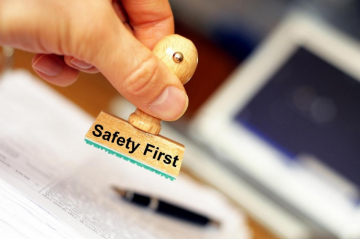Congratulations, EHS leaders. Workplace injuries are on the decline — a trend that’s been over a decade in the making.
In fact, according to a recent release from the U.S. Bureau of Labor Statistics (BLS), there were 45,800 fewer recordable workplace injuries and illnesses reported by employers in 2017. And according to EHS Today, data also shows that there’s been a steady improvement rate across industry sectors for the last 14 years.
Of course, this all boils down to fewer injuries, workers’ compensation claims, and days away from work — ensuring your employees can feel safe and be more productive and helping your organization bolster its business.
From better technology to increasing health and safety commitments, there are a myriad of reasons why work environments are safer than they were a decade ago. But we’d also wager that your contributions to guiding and managing compliance, and employee training and engagement have been big helpers.
But now is not the time to sit back and rest on your laurels. If you want the EHS momentum to continue within your own organization, you need to stay focused. Below we offer some strategic and tactical advice to help you on your way.
1. Audit your EHS strategy
EHS isn’t just about compliance; compliance is the minimum. A successful EHS strategy not only helps mitigate risk and decrease workplace injuries, but it also helps engage employees in regular health and safety best practices. And creating a culture of EHS within your organization can help ensure that EHS becomes a part of your employees’ everyday lives.
Even if you think EHS is working like a well-oiled machine, we recommend regularly reviewing your existing strategy and the data you have at your disposal. Gather your team and ask:
- What’s working and what’s not?
- Where are our greatest opportunities to gain momentum?
- Where do our greatest risk points exist?
A safer work environment is a more productive work environment. And a productive work environment leads to a healthier business and more provable EHS value.
2. Renew your investments in ongoing training
Ongoing EHS training is critical to the continued success of your programs and compliance. Not only does ongoing training ensure your employees are apprised of the latest policy changes or best practices, but it also keeps EHS top of mind — contributing to that culture of safety.
Work with your human resources department to build or refine a formal process around continual learning and training. In addition, consider incorporating new hands-on exercises or activities to spur better engagement.
For example, consider adding exercises that are designed to improve observational skills. The goal here is to improve hazard recognition, arm employees with the right steps to mitigate the issue, and empower them to take action.
3. Double-down on employee engagement
Employees, whether they be part of the leadership team or in the daily execution trenches, are the ones who are vulnerable to workplace safety risks — and they have the power to mitigate them.
But in order to take action, employees need to understand what EHS is, why it’s important, and how they can play a meaningful role. They need to be sold on EHS which means you should focus on creating a tailored employee engagement strategy. We suggest taking steps to:
- Position EHS as a benefit, not an obligation.
- Add context around EHS in employees’ everyday lives.
- Praise and share the good work being done.
Beyond creating compelling EHS messaging and sharing wins, consider adding an element of flair and fun. For example, sponsor a regular, informal, on-site activity such as a lunch and learn or doughnut day, invest in EHS swag, or add a gamification element to your program that encourages participation.
4. Go beyond environmental hazards and consider psychosocial risks
Managing psychosocial risks are the new frontier of health and safety. In fact, the European Union has already begun putting regulations in place to equate psychosocial stress with physical risks. This has immediate implications for EHS leaders managing facilities in the EU, but it should be on all EHS leaders’ radar.
Now is the time to start looking beyond traditional environmental risks and infuse psychosocial considerations within your risk assessment process. This is another opportunity to partner with your human resources department, working together to assess the gap between psychosocial need and relevant support services.
“There is a real business driver to get this right, since employee retention, productivity, and brand reputation are all on the line,” Peylina Chu, Vice President and Technology Segment Leader at Antea Group says.
5. Build relationships across departments — especially in the C-suite
The most successful EHS initiatives are those that are rooted in company culture. As we mentioned earlier, when everyone understands the risks, the value, and the impact they can have, everyone can feel more safe, productive, and empowered.
But for maximum impact, your EHS department needs cooperation and participation from stakeholders from across your company — especially your leadership team.
Getting buy-in from the C-suite will give your EHS initiatives credibility throughout the entire organization, demonstrating the company cares for and values its employees. To gain that buy-in, focus on communicating what is most material to your leadership audience.
More than likely, some of your executives may not fully understand the value of EHS, giving you the opportunity to put a business case forward. You know a happy, healthy, and safe work environment can help protect the business from noncompliance fines, reduce workers’ compensation claims, and boost productivity, ultimately protecting the business’s reputation and bottom line. Prove it to them.
In addition, working with leaders from other departments such as human resources, sales, product development, or distribution allows you to get everyone on the same page and weave EHS into all major functions. Ultimately, this will help EHS filter down through the ranks, strengthening your culture around health and safety.
Ready. Set. Focus.
Decreasing workplace injuries is cause for celebration among EHS leaders and business leaders everywhere. Take pride in the work you’ve done to diminish injury. But also recognize there’s still work to be done.
By taking the time to critically review your existing EHS strategy, investing in ongoing EHS training and stakeholder engagement, elevating your definition of environmental risk, and building relationships across the organization, you can continue to make gains.
If you’re ready to see the number of injuries at your workplace continue to decrease, but you don’t have the bandwidth or expertise, we’re here to help. Learn more about our health and safety consulting services.
Follow us on Twitter and LinkedIn for more EHS and sustainability news and insights.
Want more news and insights like this?
Sign up for our monthly e-newsletter, The New Leaf. Our goal is to keep you updated, educated and even a bit entertained as it relates to all things EHS and sustainability.
Get e-NewsletterHave any questions?
Contact us to discuss your environment, health, safety and sustainability needs today.





